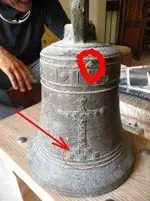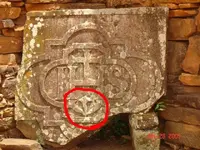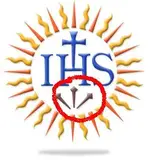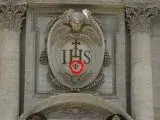Dear bobadilla;
As far as I am aware, the numeral 19 does not hold any special religious significance within the realm of the Roman Catholic church or any of Her religious Orders. As I was taught, here are the religious numbers associated with the Chruch:
One stands for the oneness of nature in God; also one divine person in Christ; one true Church founded by Christ; and there is one mortal life, one baptism, one death, and after death one judgment before eternity.
Two represents the two distinct natures in Christ, human and divine; the two covenants of God with the human race, the Old and the New; two ultimate kinds of reality, variously called heaven and earth, soul and body, spirit and matter; there are two basic commandments, to love God and one's neighbor as oneself; and the final separation on the Last Day into two groups, the saved and the lost.
Three is the number of persons in the Trinity; Christ spent three in the tomb and rose from the dead on the third day.
Four evangelists wrote the Gospels; the heavenly City of God is perfectly square, with all its dimensions a multiple of four; and there are four cardinal virtues, prudence, justice, temperance, and fortitude.
Five wounds in Christ's two hands and feet and his side are still present in his glorified body.
Six were the days of creation, signifying completion and symbolizing the principal attributes of God, namely his power, majesty, wisdom, love, mercy, and justice.
Seven is the symbolic number of charity, grace, and the Holy Spirit. It is the term that stands for perfection. There are seven sacraments, seven gifts of the Holy Spirit, seven deadly sins, seven joys, and seven sorrows of Our Lady.
Eight is associated with joy and the resurrection. There are eight beatitudes, and Christ rose from the grave on the eighth day after his triumphal entry into Jerusalem, symbolized in the octagonal shape of many baptismal fonts.
Nine is the angelic number, since the Bible speaks of the nine choirs of angles. It is also the typical number of prayer, because the first Christian novena was the nine full days that the Disciples stayed in the Upper Room and prayed after Christ's Ascension until Pentecost Sunday.
Ten stands for the Ten Commandments that Christ confirmed for his followers; it is the basic multiple for fullness, and any number multiplied by ten (or tens) is the highest possible.
Eleven has come to mean incompleteness, as typified among the Apostles after the defection of Judas, who had to be replaced before the Day of Pentecost.
Twelve implies maturity or totality. there were Twelve Apostles, corresponding to the Twelve Tribes of Israel; and the Book of Revelation is filled with imagery built around this number. The heavenly Jerusalem will be twelve thousand furlongs on all sides, having twelve jeweled foundations, with twelve gates of twelve pearls. There are twelve fruits of the Holy Spirit.
Thirteen is the symbol of teacher, recalling the presence of the traitor at the Last Supper, beyond Christ and the faithful eleven disciples.
Forty is the biblical number for trial, testing, or waiting. The flood lasted forty days and forty nights; the Israelites wandered forty years in the wilderness; Moses remained forty days on Mount Sinai. After his baptism, Christ was forty days in the desert and there was tempted by the devil. After his Resurrection, he appeared to the disciples for forty days before the Ascension. There are now forty days of Lent, and forty is the symbol of the church Militant.
fifty is related to the fulfillment of a divine promise. In later Jewish history the feast of Pentecost was celebrated on the fiftieth day after the Passover to commemorate the giving of the Law through Moses. And the Holy Spirit promised by the Savior descended on the fiftieth day after Easter.
One hundred is the scriptural number for plentitude, whether used alone or as a multiple for other numbers. Christ spoke of a hundredfold harvest and a hundredfold reward.
One thousand often means simply an immense number, too large to be counted. It has come to symbolize eternity, because all higher numbers are either an addition to a thousand or multiplications of the same. God is the Eternal One in whom there is no time element, for "with the Lord, 'a day' can mean a thousand years, and a thousand years is like a day" (II Peter 3:8).
Your friend;
LAMAR
As far as I am aware, the numeral 19 does not hold any special religious significance within the realm of the Roman Catholic church or any of Her religious Orders. As I was taught, here are the religious numbers associated with the Chruch:
One stands for the oneness of nature in God; also one divine person in Christ; one true Church founded by Christ; and there is one mortal life, one baptism, one death, and after death one judgment before eternity.
Two represents the two distinct natures in Christ, human and divine; the two covenants of God with the human race, the Old and the New; two ultimate kinds of reality, variously called heaven and earth, soul and body, spirit and matter; there are two basic commandments, to love God and one's neighbor as oneself; and the final separation on the Last Day into two groups, the saved and the lost.
Three is the number of persons in the Trinity; Christ spent three in the tomb and rose from the dead on the third day.
Four evangelists wrote the Gospels; the heavenly City of God is perfectly square, with all its dimensions a multiple of four; and there are four cardinal virtues, prudence, justice, temperance, and fortitude.
Five wounds in Christ's two hands and feet and his side are still present in his glorified body.
Six were the days of creation, signifying completion and symbolizing the principal attributes of God, namely his power, majesty, wisdom, love, mercy, and justice.
Seven is the symbolic number of charity, grace, and the Holy Spirit. It is the term that stands for perfection. There are seven sacraments, seven gifts of the Holy Spirit, seven deadly sins, seven joys, and seven sorrows of Our Lady.
Eight is associated with joy and the resurrection. There are eight beatitudes, and Christ rose from the grave on the eighth day after his triumphal entry into Jerusalem, symbolized in the octagonal shape of many baptismal fonts.
Nine is the angelic number, since the Bible speaks of the nine choirs of angles. It is also the typical number of prayer, because the first Christian novena was the nine full days that the Disciples stayed in the Upper Room and prayed after Christ's Ascension until Pentecost Sunday.
Ten stands for the Ten Commandments that Christ confirmed for his followers; it is the basic multiple for fullness, and any number multiplied by ten (or tens) is the highest possible.
Eleven has come to mean incompleteness, as typified among the Apostles after the defection of Judas, who had to be replaced before the Day of Pentecost.
Twelve implies maturity or totality. there were Twelve Apostles, corresponding to the Twelve Tribes of Israel; and the Book of Revelation is filled with imagery built around this number. The heavenly Jerusalem will be twelve thousand furlongs on all sides, having twelve jeweled foundations, with twelve gates of twelve pearls. There are twelve fruits of the Holy Spirit.
Thirteen is the symbol of teacher, recalling the presence of the traitor at the Last Supper, beyond Christ and the faithful eleven disciples.
Forty is the biblical number for trial, testing, or waiting. The flood lasted forty days and forty nights; the Israelites wandered forty years in the wilderness; Moses remained forty days on Mount Sinai. After his baptism, Christ was forty days in the desert and there was tempted by the devil. After his Resurrection, he appeared to the disciples for forty days before the Ascension. There are now forty days of Lent, and forty is the symbol of the church Militant.
fifty is related to the fulfillment of a divine promise. In later Jewish history the feast of Pentecost was celebrated on the fiftieth day after the Passover to commemorate the giving of the Law through Moses. And the Holy Spirit promised by the Savior descended on the fiftieth day after Easter.
One hundred is the scriptural number for plentitude, whether used alone or as a multiple for other numbers. Christ spoke of a hundredfold harvest and a hundredfold reward.
One thousand often means simply an immense number, too large to be counted. It has come to symbolize eternity, because all higher numbers are either an addition to a thousand or multiplications of the same. God is the Eternal One in whom there is no time element, for "with the Lord, 'a day' can mean a thousand years, and a thousand years is like a day" (II Peter 3:8).
Your friend;
LAMAR



 What I should have said was "both avenues are very important". But I do think the cargo manifest will also tell us lots about the bell if we can identify the ship and find its records. When they unloaded, they had to know where things were to be delivered, and who got what. That could narrow the search you and Laura are undertaking considerably. Don't ever think that I don't fully appreciate your contributions to the discussion, I do very much.
What I should have said was "both avenues are very important". But I do think the cargo manifest will also tell us lots about the bell if we can identify the ship and find its records. When they unloaded, they had to know where things were to be delivered, and who got what. That could narrow the search you and Laura are undertaking considerably. Don't ever think that I don't fully appreciate your contributions to the discussion, I do very much.



